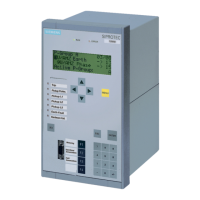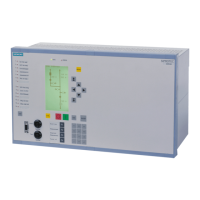alarm
LOCKOUT
(No. 530), if interconnected correspondingly, a reclosure of the circuit breaker (e.g. for auto-
matic reclosure, manual close signal, synchronization, closing via control) can be blocked. Only once the cause
for the protection operation is known, should the interlocking be reset by a manual reset via binary input
>Lockout RESET
(No. 386).
[logik-we-verriegelung-wlk-020802, 1, en_GB]
Figure 2-69 Reclosure Interlocking
Conditions which cause reclosure interlocking and control commands which have to be interlocked can be set
individually. The two inputs and the output can be wired via the correspondingly allocated binary inputs and
outputs or be linked via user-defined logic functions (CFC).
If, for example, each trip by the protection function has to cause a closing lock-out, then combine the tripping
command
Relay TRIP
(No. 511) with the locking input
>Lockout SET
. If automatic reclosure is used, only
the final trip of the protection function should activate reclosing lock-out. Remember that the indication
Definitive TRIP
(No. 536) only continues 500 ms. Then c
Definitive TRIP
(No. 536) with the inter-
locking input
>Lockout SET
, so that the interlocking is not activated if an automatic reclosure is still
expected.
You can configure the output indication
LOCKOUT
(No 530) in the simplest case without other links to the
same output that operated the trip of the circuit breaker. Then the tripping command is maintained until the
interlock is reset via the reset input. This requires the close coil at the circuit breaker to be blocked as usual for
as long as a tripping command is maintained.
The output indication
LOCKOUT
can also be applied to interlock certain closing commands (externally or via
CFC), e.g. by combining the output alarm with the binary input
>Blk Man. Close
(No. 357) or by
connecting the inverted alarm with the bay interlocking of the feeder.
The reset input
>Lockout RESET
(No. 386) resets the interlocking state. This input is initiated by an external
device which is protected against unauthorized or unintentional operation. The interlocking state can also be
controlled by internal sources using CFC, e.g. a function key, operation of the device or using DIGSI on a PC.
For each case please ensure that the corresponding logic operations, security measures, etc. are taken into
account when routing the binary inputs and outputs and may have to be considered when creating the user-
defined logic functions. See also the SIPROTEC 4 System Description.
Breaker Tripping Alarm Suppression
On feeders without automatic reclosure, every trip command by a protection function is final. But when using
automatic reclosure, it is desired that the operation detector of the circuit breaker (fleeting contact at the
breaker) should only generate an alarm if the trip of the breaker is final (Figure 2-70).
To accomplish this, the signal from the circuit breaker can be routed via an output contact of the 7VK61
(output alarm
CB Alarm Supp
, No. 563) that is configured accordingly. In the idle state and when the
device is turned off, this contact is closed. This requires that a normally closed contact is allocated. Which
contact is to be allocated depends on the device version. See also the general views in the Appendix.
Prior to a trip command with the internal automatic reclosure in the ready state, the contact opens so that the
tripping of the circuit breaker is not passed on. This is only the case if the device is equipped with internal
automatic reclosure and if the latter was taken into consideration when configuring the protection functions
(address 133).
Also when closing the breaker via the binary input
>Manual Close
(No. 356) or via the integrated automatic
reclosure the contact is interrupted so that the breaker alarm is inhibited.
Further optional closing commands which are not sent via the device are not taken into consideration. Closing
commands for control can be linked to the alarm suppression via the user-defined logic functions (CFC).
Functions
2.8 Function Control and Circuit Breaker Test
SIPROTEC 4, 7VK61, Manual 157
C53000-G1176-C159-5, Edition 05.2018

